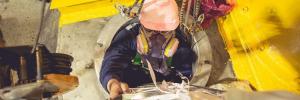Confined spaces are often home to hazardous atmospheres, including oxygen deficiency and dangerous concentrations of gasses.
LOS ALAMITOS, CA, UNITED STATES, June 1, 2022 /EINPresswire.com/ -- In addition, they present an immediately dangerous to life and health (IDLH) atmosphere. Therefore, appropriate respiratory protection is vital to ensuring worker protection.
Here’s everything one needs to know to keep workers safe in confined spaces with a
Choosing the Appropriate Respiratory Protection
Once a confined space atmosphere is analyzed, select the proper respiratory protection for all confined space entrants. Recommended respirators for confined spaces include:
- Confined space SCBA (self-contained breathing apparatus)
- Air-purifying respirators
- Dual-purpose SCBA
- Escape respirators
- Combination of airline respirators with escape cylinder
Since these devices vary in design, protective capability, and application, one needs to assess their worksite contaminant levels and stay updated with respiratory protection device limitations to select the right option. In addition, some of these respirators can be used for different hazardous atmospheres, but when conditions reach oxygen deficiency or IDLH levels, the highest levels of protection are required.
Self-contained breathing apparatus only offer this level of protection in a confined space. This apparatus is equipped with air cylinders that a user can wear to access dependable but limited air supply without needing tethers or hose lines that might restrict their movement.
SCBA Components & Requirements
Significant SCBA components include an air cylinder, a regulator, a low-pressure warning device, a face piece, and a carrier and harness assembly. An SCBA is handy for confined spaces with entrances that easily accommodate an entrant wearing an SCBA and its cylinder. For tighter confined spaces, get a low-profile cylinder. An entrant should never be exposed to a hazardous atmosphere without SCBA equipment.
OSHA requires workers to use SCBA to combine pressure-demand airline respirators with escape cylinders for entering confined spaces with IDLH environments. When carrying the latter, a worker cannot use the escape cylinder for entry and must use the airline as the primary air source because the cylinder is for escape only.
For a combination airline apparatus and self-contained breathing apparatus, Grade D breathing air is regulated down from higher pressures for delivery to the facepiece. Pressure demand respirators consistently maintain a slight positive pressure on the facepiece to avoid inward contaminant leakage.
A self-contained breathing apparatus is available in 2216 or 3000 psi (low-pressure) and 4500 or 5500 psi (high-pressure) units. With a high-pressure device, an SCBA can select cylinders that can last for 30, 40, and 60 minutes. 30-minute-rated cylinders are commonly used with low-pressure SCBA.
Ideally, workers should look for an industrial confined space SCBA that offers National Fire Protection Association (NFPA) and National Institute for Occupational Safety & Health (NIOSH) respiratory protection and unmatched comfort. In addition, it should be lightweight and feature a chemical-resistant harness with cylinder options so that workers can match their apparatus to their work conditions.
Inspections & Tests for Confined Space SCBA
Before using an SCBA in confined spaces, workers must perform basic inspections and functional tests. These include visually inspecting the self-contained breathing apparatus components, including the lenses, straps, and airline hose. It will ensure that there is no damage, wear, etc., and the air cylinder is full.
Inspections should also include functional tests to check that the buckles actually buckle, the self-contained breathing apparatus does not leak, and the regulators and warning devices activate when required. These inspections typically do not require the use of specialized equipment. NFPA, OSHA, and SCBA manufacturers specify what a self-contained breathing apparatus inspection should include.
Apart from the basic inspection, you should also perform a flow test. Also known as a performance test, a flow test ensures that an SCBA performs according to the manufacturer’s specifications. Unlike functional testing and fundamental inspections, flow testing demands the use of specialized equipment known as a breathing machine.
NFPA 1852 mentions the criteria a breathing machine should meet, including the tests it needs to perform and the exact curve of the breathing rates. For an easy, instant analysis, the flow test results need to be graphical or numerical. SCBA testing is typically used as a synonym for a flow test.
Frequency of SCBA Tests
OSHA advises SCBAs should be inspected before every use, when they clean them, and at least every month. According to NFPA 1852, workers should inspect their designated self-contained breathing apparatus at the beginning of their shift. For SCBAs not assigned to specific workers, the inspection interval should never be more than one week.
Moreover, many SCBA manufacturers recommend that SCBA be inspected before and after every use, although the recommendation for infrequently used apparatuses varies. These are all minimum requirements, but they should be followed since they keep workers safe when on the job and prevent the need for dangerous confined space rescue.
OSHA does not have a specification for the frequency of flow testing. In fact, the words “flow testing” do not appear in its code. With that said, the NFPA and SCBA manufacturers recommend performing at least one flow test every year. Moreover, NFPA 1852 states that a flow test must be performed on the new SCBA before allowing workers to use it. It also states that tests should be conducted after repairing or rebuilding.
Frequent flow testing can avoid SCBA problems in confined spaces. It will also help with awareness of problems that might arise due to repeated exposure to water, chemicals, and extreme temperatures.
Confined Space Air Monitoring
Before using SCBA to enter a confined space, perform a remote entry test. It requires testing the internal atmosphere with a calibrated direct-reading instrument. This test enables oxygen content to be read and checked for potential toxic air contaminants. Ideally, use a pre-entry or remote test to ensure comprehensive confined space air monitoring for all confined spaces.
DCS Rescue provides all the necessary SCBA apparatus and the required planning documentation to fulfill regulatory requirements associated with confined space rescue services and SCBA.


No comments:
Post a Comment